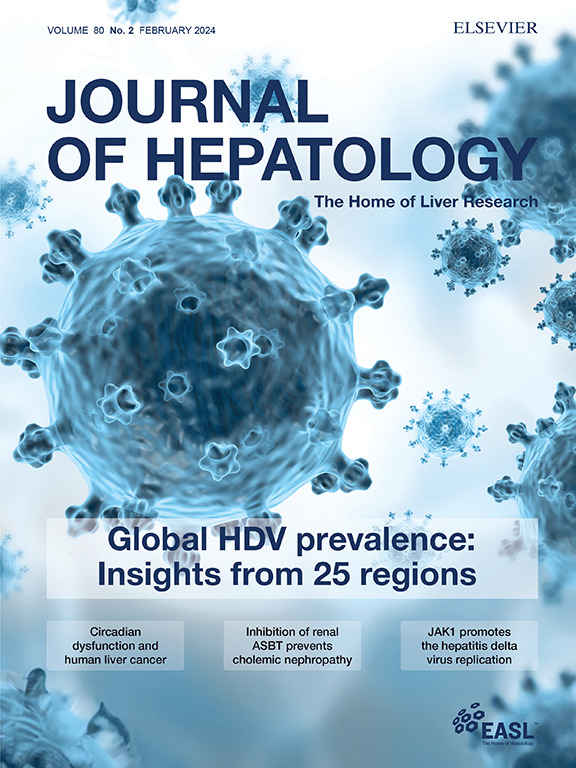Of mice and men: Unlocking precision medicine for liver cancer
IF 26.8
1区 医学
Q1 GASTROENTEROLOGY & HEPATOLOGY
引用次数: 0
Abstract
Section snippets
Background and context
Whilst widening adoption of next-generation sequencing has redefined management of most cancers by allowing identification of molecularly defined patient subgroups matched with targeted therapeutic options, hepatocellular carcinoma (HCC) has remained virtually untouched by the molecular revolution of cancer care.1The extent of this unmet need is perhaps epitomized by considering how the anatomic proximity of biliary and hepatocellular tumours contrasts with the abyssal molecular distanceObjectives, methods, and findings
By selecting somatic mutational events for their pro-tumorigenic potential in HCC, Mueller and collaborators used cancer genome atlas data to design highly hepato-specific adenoviral vectors capable of transfecting adult mouse hepatocytes in an immunocompetent environment. Each resulting cohort of genetically modified mice was characterized by the presence of tumours harbouring one or more distinctive initiating molecular events such as TP53, CDKN2A, PTEN, AXIN1, BAP1 loss of function mutationsSignificance of findings
The extensive body of pre-clinical work published by Mueller et al. represents an important advance in therapeutic drug development for HCC. First, discovery of high-fidelity pre-clinical models with improved resemblance to human HCC is posited to improve our understanding of mechanisms of efficacy and resistance to novel systemic treatments for liver cancer. Not all therapeutic combinations can be directly tested upfront in patients, where surrogate measures of anti-tumour efficacy oftenFinancial support
The author did not receive any financial support to produce this manuscript.Conflict of interest
DJP received lecture fees from ViiV Healthcare, Bayer Healthcare, Roche, BMS, Falk; travel expenses from BMS, MSD and Bayer Healthcare; consulting fees for Mina Therapeutics, Eisai, H3B, Roche, Boston Scientific, Astra Zeneca, DaVolterra; received research funding (to institution) from MSD, GSK, BMS.Please refer to the accompanying ICMJE disclosure forms for further details.Acknowledgements
The author would like to acknowledge the Imperial College National Institute for Health Research Biomedical Research Centre and the Imperial Experimental Cancer Medicine Centre.人鼠之间开启肝癌精准医疗
背景和背景虽然新一代测序的广泛采用通过允许识别分子定义的患者亚组与靶向治疗方案相匹配,重新定义了大多数癌症的管理,但肝细胞癌(HCC)几乎没有受到癌症治疗的分子革命的影响。考虑到胆道和肝细胞肿瘤的解剖接近性与深层分子距离的对比,这一未满足需求的程度可能是概括的。目的、方法和发现通过选择HCC中促肿瘤发生潜力的体细胞突变事件,Mueller和合作者利用癌症基因组图谱数据设计了高度肝脏特异性的腺病毒载体,能够在免疫活性环境中转染成年小鼠肝细胞。每一组转基因小鼠的特点是存在含有一种或多种独特的起始分子事件的肿瘤,如TP53、CDKN2A、PTEN、AXIN1、BAP1功能丧失突变。研究结果的意义Mueller等人发表的大量临床前工作代表了HCC治疗药物开发的重要进展。首先,高保真临床前模型的发现与人类HCC的相似性有所提高,有望提高我们对肝癌新型全身治疗的疗效和耐药机制的理解。并不是所有的治疗组合都可以直接在患者中进行前期测试,而抗肿瘤疗效的替代措施通常是财政支持作者没有获得任何财政支持来撰写这篇论文。利益冲突djp获得ViiV Healthcare、Bayer Healthcare、Roche、BMS、Falk的讲座费用;BMS、MSD和拜耳医疗的差旅费用;Mina Therapeutics、卫材、H3B、Roche、Boston Scientific、Astra Zeneca、DaVolterra的咨询费;获得MSD, GSK, BMS的研究经费(对机构)。详情请参阅随附的ICMJE披露表格。作者要感谢帝国理工学院国家卫生研究所生物医学研究中心和帝国实验癌症医学中心。
本文章由计算机程序翻译,如有差异,请以英文原文为准。
求助全文
约1分钟内获得全文
求助全文
来源期刊

Journal of Hepatology
医学-胃肠肝病学
CiteScore
46.10
自引率
4.30%
发文量
2325
审稿时长
30 days
期刊介绍:
The Journal of Hepatology is the official publication of the European Association for the Study of the Liver (EASL). It is dedicated to presenting clinical and basic research in the field of hepatology through original papers, reviews, case reports, and letters to the Editor. The Journal is published in English and may consider supplements that pass an editorial review.
 求助内容:
求助内容: 应助结果提醒方式:
应助结果提醒方式:


